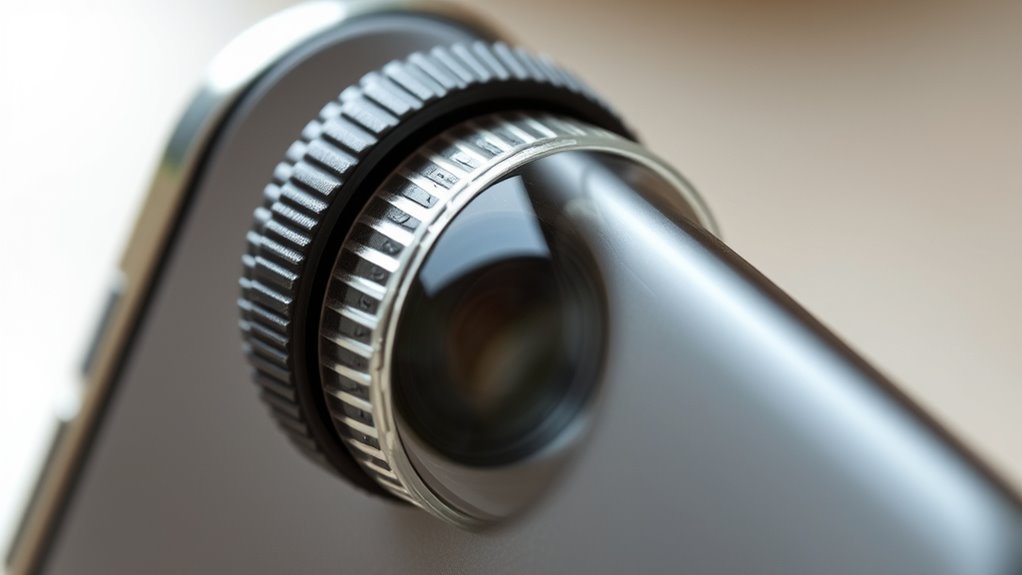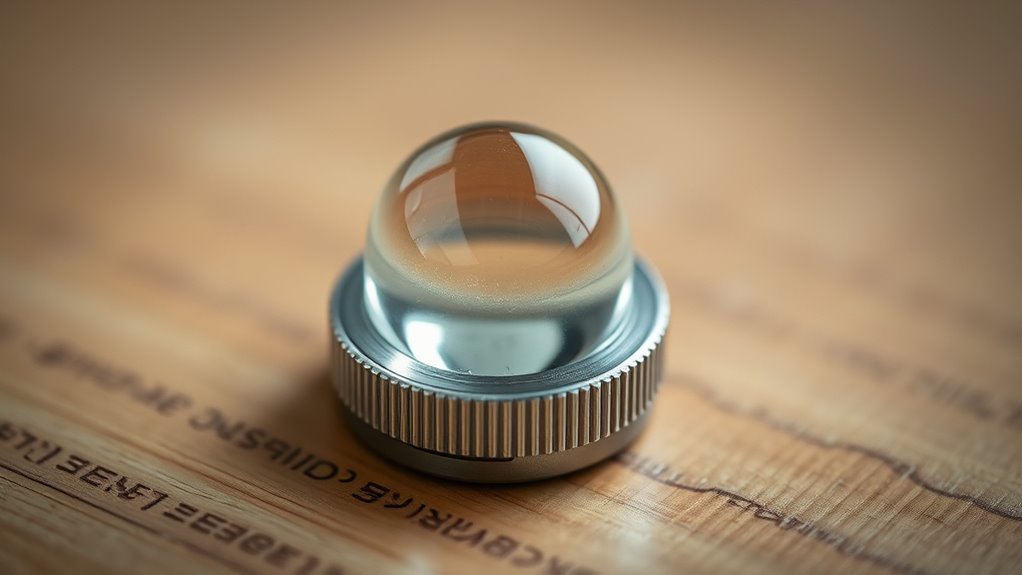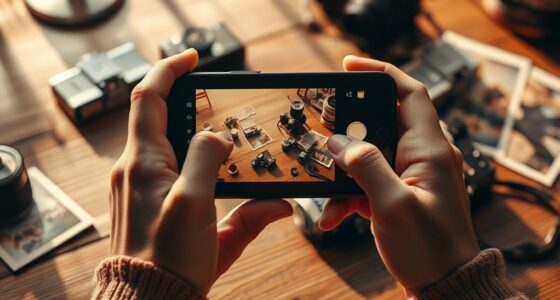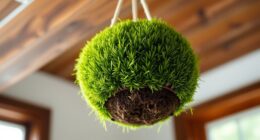To make a macro lens for your smartphone, find a small optical lens like a magnifying glass or camera lens from an old device. Secure it over your phone’s camera with super glue or double-sided tape, ensuring it’s centered and stably attached. Adjust the distance between the lens and your object for the best focus. With a little experimentation, you’ll capture incredible close-up details—keep going to discover more tips for perfect shots.
Key Takeaways
- Gather a small optical lens from an old camera or magnifying glass and attach it securely over your smartphone camera.
- Use adhesive like super glue or double-sided tape to fix the lens onto a lightweight, stable casing such as a plastic syringe or cardboard tube.
- Align the lens precisely with the smartphone camera sensor to ensure clear, focused macro shots.
- Adjust the distance between the lens and object to find the optimal focus for detailed close-up photography.
- Test and experiment with different objects like insects or plant textures to maximize the macro lens’s creative potential.

Have you ever wanted to capture tiny details with your smartphone but lacked the specialized equipment? If so, making a macro lens for your device can be a game-changer. You don’t need to spend a fortune on professional gear when you can create a lens attachment with simple, everyday materials. This approach is perfect for DIY photography enthusiasts who love experimenting and honing their skills. By building your own macro lens, you’ll reveal a new world of detail, revealing textures and features invisible to the naked eye. Plus, it’s a fun project that enhances your creativity and allows full control over your photography process.
Create your own macro lens with simple materials and unlock incredible close-up shots on your smartphone.
To start, gather a few basic supplies: a small piece of magnifying glass or a high-quality lens from an old camera or optical device, some adhesive like super glue or double-sided tape, and a sturdy but lightweight tube or casing, such as a plastic syringe or a section of cardboard tube. The key is to attach this lens to your smartphone securely, aligning it perfectly with your camera’s sensor. Many DIY photography projects focus on creating a custom lens attachment that fits snugly over your phone’s existing camera module. This guarantees you don’t have to remove or modify your phone itself, making the process simple and reversible.
Positioning the lens attachment correctly is vital. Place the magnifying lens over your phone’s camera lens and secure it with the adhesive, ensuring it’s centered and stable. You might need to test different distances between the lens and your phone’s camera to achieve maximum focus. The closer the lens is to your camera sensor, the better the magnification and detail you’ll capture. Once mounted, you can experiment with different objects—tiny insects, intricate plant structures, or textured surfaces—getting up-close shots that reveal their fine details. This DIY approach to macro photography allows you to customize your setup without expensive equipment, giving you greater flexibility and creative control.
Using a lens attachment for DIY photography isn’t just about saving money; it’s about exploring new perspectives and honing your skills. It turns your smartphone into a powerful tool for macro photography, opening doors to creative projects and detailed documentation of your surroundings. With patience and some trial and error, you’ll develop a sharper eye for tiny details and improve your overall photography skills. Additionally, choosing high-quality an 100 lenses can significantly enhance the clarity and magnification of your shots. Plus, since this setup is portable and inexpensive, you can take it anywhere, capturing incredible close-up shots whenever inspiration strikes. In the end, making your own macro lens is an accessible way to elevate your smartphone photography, turning ordinary images into extraordinary, detailed works of art.
Frequently Asked Questions
Can I Make a Macro Lens Compatible With All Smartphone Models?
Yes, you can make a macro lens with universal compatibility, but it depends on the lens attachment methods you choose. If you opt for clip-on or adjustable mounts, they often fit most smartphone models. However, some lenses are designed for specific phones, so check compatibility first. Using versatile attachment methods guarantees your macro lens functions across various devices, making your macro photography more accessible and enjoyable.
What Materials Are Safest for DIY Macro Lens Construction?
You should prioritize material safety and avoid toxic chemicals when making a DIY macro lens. Use non-toxic, inert materials like acrylic or glass for the lens elements, as they’re safe and chemical-free. Avoid plastics with harmful additives or chemicals that could leach out. Always work in a well-ventilated area, and wash your hands afterward to prevent any chemical exposure. Ensuring material safety keeps your project safe and environmentally friendly.
How Do I Attach the Macro Lens Securely to My Phone?
To attach your macro lens securely, use a clip or a DIY mount that offers strong lens attachment and stability. Make sure it fits snugly over your phone’s camera, preventing any wobbling or shifting during use. You can also add a rubber or foam padding for extra grip. Test the setup before shooting, addressing any stability concerns to guarantee sharp, clear macro shots without the lens slipping.
Will DIY Macro Lenses Affect My Phone’s Camera Quality?
Think of your phone’s camera as a window to a tiny world, and your DIY macro lens as a magnifying glass. While it might introduce some lens distortion, it usually doesn’t ruin your image clarity. You might notice slight blurriness or color shifts, but with careful assembly, your macro lens can deliver sharp, detailed close-ups. Just keep in mind, quality matters—cheaper lenses may impact your photos more.
How Durable Are Homemade Macro Lenses for Regular Use?
Homemade macro lenses can be quite durable if you choose quality materials like sturdy plastic or glass. With proper care, your lens longevity improves, and material wear remains minimal during regular use. However, if you use cheap materials or handle them roughly, they may degrade faster or get scratched. To guarantee durability, clean your lens carefully and store it properly, avoiding excessive force or impacts that could damage the construction.
Conclusion
Now that you’ve crafted your own macro lens, you’re ready to explore the tiny details of the world around you. Just like a keen explorer with a magnifying glass, your DIY lens reveals hidden wonders that often go unnoticed. With a little creativity and effort, you can transform your smartphone into a powerful microscope. So go ahead, get close and personal—your miniature universe awaits, waiting to be uncovered like a secret waiting to be told.








